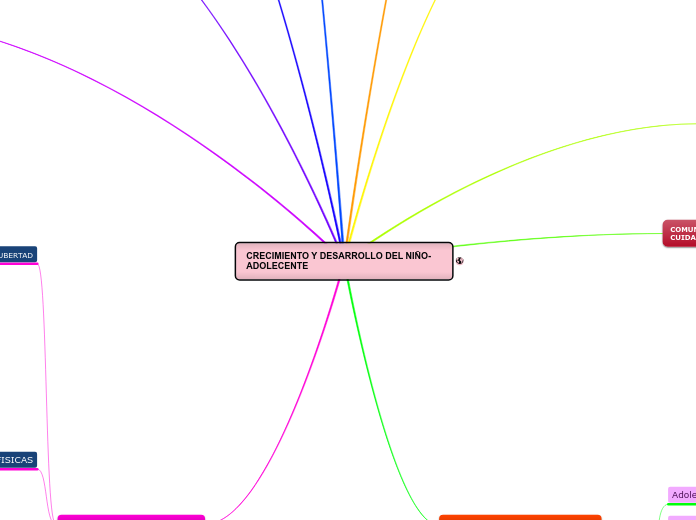CRECIMIENTO Y DESARROLLO DEL NIÑO-ADOLECENTE
DESARROLLO DEL NIÑO
0 A 3
ESTAN ABIERTOS ALA ESTIMULACION
CURIOSIDAD
SONREIN
MUESTRAN INTERES
Topic principal
3 A 6
PUEDEN ANTICIPAR LO QUE ESTA APUNTO DE SUCEDER
ENOJANDOSE
RECELO
SONREIR Y RIEN CON FRECUENCIA
6 A 9
PARTICIPAN EN JUEGOS SOCIALES
HABLAN A OTROS BEBES
EXPRESAN EMOCIONES
9 A 12
SE RELACIONAN CON SU CUIDADOR
SIENTEN TEMOR
ACTUUAN TIMIDAMENTE
12 A 18
EXPLORAN SU MEDIO AMBIENTE
COMIENZAN A DAR SUS PRIMEROS PASOS
MUESTRAN MAS ENTUSIASTAS
18 A 36
MUESTRAN ANSIEDAD
ELABORAN SU CONCIENCIA
COMIENZAN A IDENTIFICAR ALOS ADULTOS
EMOCIONES DE LOS NIÑOS
Primeros signos de la emoción
Demuestran con claridad los momentos en que se sienten infelices
Suelen tranquilizarse ante
el sonido de una voz humana o cuando son tomados en brazos.
FORMAS DE EMOCIONES
LLANTO DE HAMBRE
LLANTO DE ENOJO
LLANTO DE DOLOR
LLANTO DE FUSTRACION
SONRISASD Y RISAS
SONRISA SOCIAL
TEMPERAMENTO DE LOS NIÑOS
NIÑO FACIL
NIÑO DIFICIL
NIÑO LENTO PARA ANIMARSE
COMUNICACIÓN EMOCIONAL CON LOS CUIDADORES
REFERENCIACIÓN SOCIAL
Desarrollo psicosocial del adolescente
FASES
Adolescencia temprana
10 a los 13-14 anos
Adolescencia media
4-15 a los 16-17 anos
Adolescencia tardía
s 17-18 anos en adelante
CRECIMIENTO DEL NIÑO
FASES DEL CRECIMIENTO FÍSICO
C.RAPIDO
0 A 1 AÑO
3 A 4 DIAS
0 A 2 MESES
3 A 6 MESES
7 A 12 MESES
1 A 2 AÑOS
F. TRANSICION
2 A 3 AÑOS
C. LENTO Y ESTABLE
3 A 6 AÑOS
Group 1
Project Name
Short Project Description
Team Members
Student Name
Student Name
FACTORES
F. NUTRICIONALES
F. SOCIOECONOMICOS
F. EMOCIONALES
F. NEUROENDOCRINOS
TRANSTORNOS
RETRASO DEL CRECIMIENTO INTRAUTERINO (RCIU)
BAJO PESO AL NACER
RIESGO A NACER MUERTO
BAJO EN AZUCAR EN LA SANGRE
DIFICULTAD PARA MANTENER LA TEMPERATURA CORPORAL
TALLA BAJA
RETRASO DE LA TALLA CONSTITUCIONAL
RETRASO DE LA TALLA FAMILIAR
ACROMEGALIA O GIGANTISMO
ENANISMO
MADURACION
DENTARIA
SEXUAL
PSICOMOTRIZ
OSEA
CONTROL DEL CRECIMINETO
RECIEN NACIDO
4
48 HORAS
7
14
21
MENOR DE 12 MESES
11
1M, 2M, 3M, 4M, 5M, 6M, 7M, 8M, 9M, 10M, 11M
1 AÑO
6
12M, 14M, 16M, 18M, 20M, 22M
2 A 4 AÑOS
4
24M 27M 30M 33M 36M 39M 42M 45M 48M 51M 54M 57M
5 A 11 AÑOS
1
AL AÑO
CRECIMIENTO DEL ADOLESCENTE
PUBERTAD
La activación de las glándulas suprarrenales.
La maduración de los órganos sexuales
NIÑA
Vello púbico y axilar
Desarrollo de los senos
NIÑO
Incrementan la producción de
andrógenos
Testosterona
Masa muscular
Vello corporal
Piel gruesa y grasosa
Acne
Cambio de voz
CARACTERISTICAS FISICAS
El estirón del crecimiento
NIÑA
9 A 14
NIÑO
10 A 16
Crecimiento muscular
NIÑA
12 Y MEDIO
NIÑO
14 Y MEDIO
SIGNOS DE LA MADURACION SEXUAL
NIÑAS
Menstruación
10 a 16 años
Subtopic
NIÑOS
primera eyaculación
13 AÑOS
TRANSTORNOS DE NUTRICION
OBESIDAD
INFLUYE
Control del peso
imagen corporal
Factores de riesgo
Ser perfeccionista
Ser mujer
Actitudes de la sociedad
Haber sufrido problemas alimentarios
ANOREXIA
BULIMIA
DROGAS
FACTORES DE RIESGO
Rechazo de los padres
Marginación y rebeldía
Fracaso académico
Problemas conductuales
Influencias familiares
